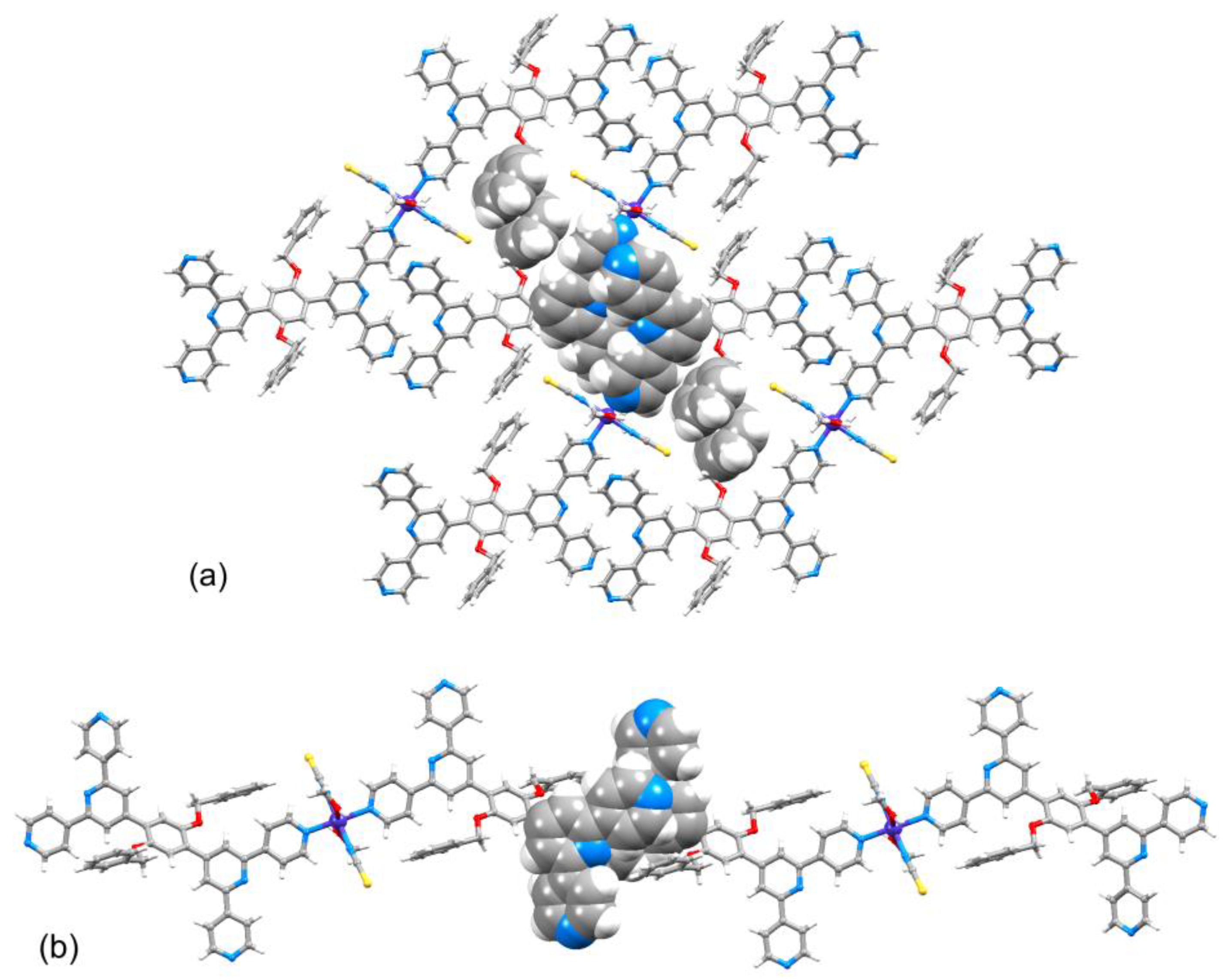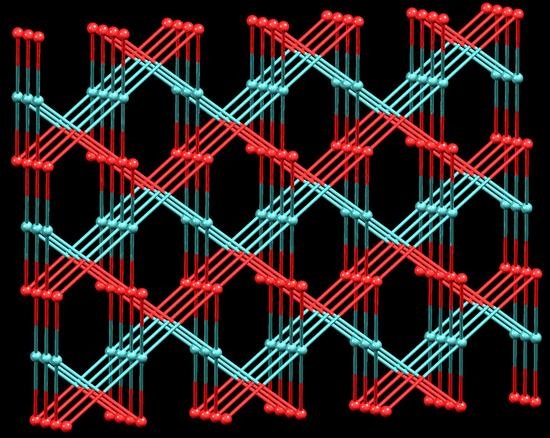Sometimes the Same, Sometimes Different: Understanding Self-Assembly Algorithms in Coordination Networks
Abstract
1. Introduction
2. Materials and Methods
2.1. General
2.2. Compound 3a
2.3. Compound 4a
2.4. Compound 5a
2.5. Compound 3b
2.6. Compound 5b
2.7. Compound 3
2.8. Compound 4
2.9. Compound 5
2.10. {[Co(NCS)2(3)]·0.8C6H4Cl2}n
2.11. {[Co(NCS)2(4)]·1.6H2O·1.2C6H4Cl2}n
2.12. [Co(NCS)2(MeOH)2(5)2]·2CHCl3·2MeOH
2.13. Crystallography
3. Results
3.1. Synthesis and Characterization of Ligands
3.2. Crystal Growth
3.3. {[Co(NCS)2(3)]·0.8C6H4Cl2}n and {[Co(NCS)2(4)]·1.6H2O·1.2C6H4Cl2}n
3.4. [Co(NCS)2(MeOH)2(5)2]·2CHCl3·2MeOH
4. Conclusions
Supplementary Materials
Author Contributions
Funding
Conflicts of Interest
References
- Biradha, K.; Sarkar, M.; Rajput, L. Crystal engineering of coordination polymers using 4,4′-bipyridine as a bond between transition metal ions. Chem. Commun. 2006, 4169–4179. [Google Scholar] [CrossRef]
- Ye, B.-H.; Tong, M.-L.; Chen, X.-M. Metal-organic molecular architectures with 2,2′-bipyridyl-like and carboxylate ligands. Coord. Chem Rev. 2005, 249, 545–565. [Google Scholar] [CrossRef]
- Constable, E.C.; Housecroft, C.E. Ligand and Metalloligand Design for Macrocycles, Multimetallic Arrays, Coordination Polymers and Assemblies. In Elsevier Reference Module in Chemistry, Molecular Sciences and Chemical Engineering; Reedijk, J., Ed.; Elsevier: Waltham, MA, USA, 2016. [Google Scholar]
- Byrne, J.P.; Kitchen, J.A.; Gunnlaugsson, T. The btp [2,6-bis(1,2,3-triazol-4-yl)pyridine] binding motif: A new versatile terdentate ligand for suprmolecualr and coordination chemistry. Chem. Soc. Rev. 2014, 43, 5302–5325. [Google Scholar] [CrossRef] [PubMed]
- Adarsh, N.N.; Dastidar, P. Coordination polymers: What has been achieved in going from innocent 4,4′-bipyridine to bis-pyridyl ligands having a non-innocent backbone? Chem. Soc. Rev. 2012, 41, 3039–3060. [Google Scholar] [CrossRef]
- Constable, E.C. Coordination Polymers. In Supramolecular Chemistry: From Molecules to Nanomaterials; Reedijk, J., Ed.; Elsevier: Waltham, MA, USA, 2016; Volume 6, p. 3073. [Google Scholar]
- Janiak, C.; Veith, J.K. MOFs, MILs and more: Concepts, properties and applications for porous coordination networks (PCNs). New J. Chem. 2010, 34, 2366–2388. [Google Scholar] [CrossRef]
- Constable, E.C. Expanded ligands–An assembly principle for supramolecular chemistry. Coord. Chem. Rev. 2008, 252, 842–855. [Google Scholar] [CrossRef]
- Chakroborty, S.; Newkome, G.R. Terpyridine-based metallosupramolecular constructs: Tailored monomers to precise 2D-motifs and 3D-metallocages. Chem. Soc. Rev. 2018, 47, 3991–4016. [Google Scholar] [CrossRef]
- Housecroft, C.E. 4,2′:6′,4′′-Terpyridines: Diverging and diverse building blocks in coordination polymers and metallomacrocycles. Dalton Trans. 2014, 43, 6594–6604. [Google Scholar] [CrossRef]
- Housecroft, C.E. Divergent 4,2′:6′,4′′- and 3,2′:6′,3′′-terpyridines as linkers in 2- and 3-dimensional architectures. CrystEngComm 2015, 17, 7461–7468. [Google Scholar] [CrossRef]
- Constable, E.C.; Housecroft, C.E. Tetratopic bis(4,2′:6′,4′′-terpyridine) and bis(3,2′:6′,3′′-terpyridine) ligands as 4-connecting nodes in 2D-coordination networks and 3D-frameworks. J. Inorg. Organomet. Polym. Mater. 2018, 28, 414–427. [Google Scholar] [CrossRef]
- Klein, Y.M.; Prescimone, A.; Pitak, M.B.; Coles, S.J.; Constable, E.C.; Housecroft, C.E. Constructing chiral MOFs by functionalizing 4,2′:6′,4′′-terpyridine with long-chain alkoxy domains: Rare examples of neb nets. CrystEngComm 2016, 18, 4704–4707. [Google Scholar] [CrossRef]
- Liu, C.; Ding, Y.-B.; Shi, X.-H.; Zhang, D.; Hu, M.-H.; Yin, Y.-G.; Li, D. Interpenetrating Metal−Organic Frameworks Assembled from Polypyridine Ligands and Cyanocuprate Catenations. Cryst. Growth Des. 2009, 9, 1275–1277. [Google Scholar] [CrossRef]
- Yang, P.; Wang, M.-S.; Shen, J.-J.; Li, M.-X.; Wang, Z.-X.; Shao, M.; He, X. Seven novel coordination polymers constructed by rigid 4-(4-carboxyphenyl)-terpyridine ligands: Synthesis, structural diversity, luminescence and magnetic properties. Dalton Trans. 2014, 43, 1460–1470. [Google Scholar] [CrossRef] [PubMed]
- Zhang, L.; Li, C.-J.; He, J.-E.; Chen, Y.-Y.; Zheng, S.-R.; Fan, J.; Zhang, W.-G. Construction of New Coordination Polymers from 4′-(2,4-disulfophenyl)- 3,2′:6′,3′′-terpyridine: Polymorphism, pH-dependent syntheses, structures, and properties. J. Solid State Chem. 2016, 233, 444–454. [Google Scholar] [CrossRef]
- Cheng, Y.; Yang, M.-L.; Hu, H.-M.; Xu, B.; Wang, X.; Xue, G. Syntheses, structures and luminescence for zinc coordination polymers based on a multifunctional 4′-(3-carboxyphenyl)-3,2′:6′,3′′-terpyridine ligand. J. Solid State Chem. 2016, 239, 121–130. [Google Scholar] [CrossRef]
- Li, N.; Zhu, Q.-E.; Hu, H.-M.; Guo, H.-L.; Xie, J.; Wang, F.; Dong, F.-X.; Yang, M.-L.; Xue, G.-L. Hydrothermal syntheses, crystal structures and luminescence properties of zinc(II) coordination polymers constructed by bifunctional 4′-(4-carboxyphenyl)-3,2′:6′,3′′-terpyridine. Polyhedron 2013, 49, 207–215. [Google Scholar] [CrossRef]
- Chen, N.; Li, M.-X.; Yang, P.; He, X.; Shao, M.; Zhu, S.-R. Chiral coordination polymers with SHG-active and luminescence: An unusual homochiral 3D MOF constructed from achiral components. Cryst. Growth Des. 2013, 13, 2650–2660. [Google Scholar] [CrossRef]
- Klein, Y.M.; Constable, E.C.; Housecroft, C.E.; Prescimone, A. A 3-dimensional {42.84} lvt net built from a ditopic bis(3,2′:6′,3′′-terpyridine) tecton bearing long alkyl tails. CrystEngComm 2015, 17, 2070–2073. [Google Scholar] [CrossRef]
- Klein, Y.M.; Lanzilotto, A.; Prescimone, A.; Krämer, K.W.; Decurtins, S.; Liu, S.-X.; Constable, E.C.; Housecroft, C.E. Coordination behaviour of 1-(3,2′:6′,3′′-terpyridin-4′-yl)ferrocene: Structure and magnetic and electrochemical properties of a tetracopper dimetallomacrocycle. Polyhedron 2017, 129, 71–76. [Google Scholar] [CrossRef]
- Zhao, M.; Tan, J.; Su, J.; Zhang, J.; Zhang, S.; Wu, J.; Tian, Y. Syntheses, crystal structures and third-order nonlinear optical properties of two series of Zn(II) complexes using the thiophene-based terpyridine ligands. Dyes Pigments 2016, 130, 216–225. [Google Scholar] [CrossRef]
- Constable, E.C.; Housecroft, C.E.; Vujovic, S.; Zampese, J.A. 2D→2D Parallel interpenetration of (4,4) sheets constructed from a ditopic bis(4,2′:6′,4′′-terpyridine). CrystEngComm 2014, 16, 3494–3497. [Google Scholar] [CrossRef]
- Vujovic, S.; Constable, E.C.; Housecroft, C.E.; Morris, C.D.; Neuburger, M.; Prescimone, A. Engineering 2D→2D parallel interpenetration using long alkoxy-chain substituents. Polyhedron 2015, 92, 77–83. [Google Scholar] [CrossRef]
- Klein, Y.M.; Prescimone, A.; Neuburger, M.; Constable, E.C.; Housecroft, C.E. What a difference a tail makes: 2D→2D parallel interpenetration of sheets to interpenetrated nbo networks using ditopic-4,2′:6′,4′′-terpyridine ligands. CrystEngComm 2017, 19, 2894–2902. [Google Scholar] [CrossRef]
- Batten, S.R.; Neville, S.M.; Turner, D.R. Coordination Polymers: Design, Analysis and Application; RSC Publishing: Cambridge, UK, 2009; Chapter 2; ISBN 978-0-85404-837-3. [Google Scholar]
- Li, D.-S.; Wua, Y.-P.; Zhao, J.; Zhang, J.; Lu, J.Y. Metal-organic frameworks based upon non-zeotype 4-connected topology. Coord. Chem. Rev. 2014, 261, 1–27. [Google Scholar] [CrossRef]
- Klein, Y.M.; Prescimone, A.; Constable, E.C.; Housecroft, C.E. 4,2′:6′,4′′- and 3,2′:6′,3′′-terpyridines: The conflict between well-defined vectorial properties and serendipity in the assembly of 1D-, 2D- and 3D-architectures. Materials 2017, 10, 728. [Google Scholar] [CrossRef]
- Prasad, T.K.; Suh, M.P. Metal-organic frameworks incorporating various alkoxy pendant groups: Hollow tubular morphologies, X-ray single-crystal structures, and selective carbon dioxide adsorption properties. Chem. Asian J. 2015, 10, 2257–2263. [Google Scholar] [CrossRef]
- Kuhnert, N.; Lopez-Periago, A.; Rossignolo, G.M. The synthesis and conformation of oxygenated trianglimine macrocycles. Org. Biomol. Chem. 2005, 3, 524–537. [Google Scholar] [CrossRef]
- Bruker Analytical X-ray Systems, Inc. APEX2, version 2 User Manual, M86-E01078; Bruker Analytical X-ray Systems, Inc.: Madison, WI, USA, 2006. [Google Scholar]
- Palatinus, L.; Chapuis, G. SUPERFLIP—A computer program for the solution of crystal structures by charge flipping in arbitrary dimensions. J. Appl. Cryst. 2007, 40, 786–790. [Google Scholar] [CrossRef]
- Betteridge, P.W.; Carruthers, J.R.; Cooper, R.I.; Prout, K.; Watkin, D.J. CRYSTALS version 12: Software for guided crystal structure analysis. J. Appl. Cryst. 2003, 36, 1487. [Google Scholar] [CrossRef]
- Bruno, I.J.; Cole, J.C.; Edgington, P.R.; Kessler, M.K.; Macrae, C.F.; McCabe, P.; Pearson, J.; Taylor, R. New software for searching the Cambridge Structural Database and visualizing crystal structures. Acta Cryst. B 2002, 58, 389–397. [Google Scholar] [CrossRef]
- Macrae, C.F.; Bruno, I.J.; Chisholm, J.A.; Edgington, P.R.; McCabe, P.; Pidcock, E.; Rodriguez-Monge, L.; Taylor, R.; van de Streek, J.; Wood, P.A. Mercury CSD 2.0—New features for the visualization and investigation of crystal structures. J. Appl. Cryst. 2008, 41, 466–470. [Google Scholar] [CrossRef]
- Wang, J.; Hanan, G.S. A facile route to sterically hindered and non-hindered 4′-aryl-2,2′:6′,2′′-terpyridines. Synlett 2005, 1251–1254. [Google Scholar] [CrossRef]
- Lee, I.S.; Shin, D.M.; Chung, Y.K. Novel supramolecular isomerism in coordination polymer synthesis from unsymmetrical bridging ligands: Solvent influence on the ligand placement orientation and final network structure. Chem. Eur. J. 2004, 10, 3158–3165. [Google Scholar] [CrossRef]
- Suckert, S.; Jess, I.; Näther, C. Crystal structure of bis (3,5-di methyl pyridine-κN)bis (methanol-κO)bis (thiocyanato-κN)cobalt(II). Acta Crystallogr. Sect. E 2016, 72, 1824–1826. [Google Scholar] [CrossRef]
- Suckert, S.; Werner, J.; Jess, I.; Näther, C. Crystal structure of bis(4-benzoylpyridine-κN)bis(methanol-κO)bis(thiocyanato-κN)cobalt(II). Acta Crystallogr. Sect. E 2017, 73, 616–619. [Google Scholar] [CrossRef]
- Yang, G.-R.; Ren, J.; Li, G.-T. Bis{N(2),N(6)-bis-[(pyridin-3-yl)methyl]pyridine-2,6-dicarboxamide- κN}bis(methanol-κO)bis(thiocyanato-κN)cobalt(II). Acta Crystallogr. Sect. E 2012, 68, m765. [Google Scholar] [CrossRef]
- Robert, F.; Naik, A.D.; Tinant, B.; Robiette, R.; Garcia, Y. Insights into the origin of solid-state photochromism and thermochromism of N-salicylideneanils: The intruging case of aminopyridines. Chem. Eur. J. 2009, 15, 4327–4342. [Google Scholar] [CrossRef]
- Zhang, P.; Wu, B.-L.; Niu, Y.-Y.; Zhang, H.-Y.; Niu, C.-Y.; Hou, H.-W. Synthesis, crystal structure and properties of the enantiotopic complex constructed from chiral ligand H2bpb, [Co(H2bpb)2(NCS)2(CH3OH)2] (H2bpb = 1,2-bis(3-pyridylcarboxamide)benzene). Synth. React. Inorg. Met. Org. Nano-Met. Chem. 2007, 37, 577–582. [Google Scholar] [CrossRef]
- Groom, C.R.; Bruno, I.J.; Lightfoot, M.P.; Ward, S.C. The Cambridge Structural Database. Acta Crystallogr. Sect. B 2016, 72, 171–179. [Google Scholar] [CrossRef]
- Yin, Z.; Zhang, S.; Zheng, S.; Golen, J.A.; Rheingold, A.L.; Zhang, G. Cobalt(II) coordination polymers versus discrete complex with 4,2′:6′,4′′-terpyridine ligands: The role of a pyrenyl substituent. Polyhedron 2015, 101, 139–145. [Google Scholar] [CrossRef]
- Janiak, C. A critical account on π-π stacking in metal complexes with aromatic nitrogen-containing ligands. J. Chem. Soc. Dalton Trans. 2000, 3885–3896. [Google Scholar] [CrossRef]












| Bond Parameter | {[Co(NCS)2(3)]·0.8C6H4Cl2}n | {[Co(NCS)2(4)]·1.6H2O·1.2C6H4Cl2}n |
|---|---|---|
| Distance/Å | ||
| Co1–N1 | 2.208 (2) | 2.238 (4) |
| Co1–N4 | 2.062 (3) | 2.065 (4) |
| Co1–N3v | 2.179 (2) | 2.169 (4) |
| Angle/deg | ||
| N1–Co1–N4 | 90.18 (10) | 88.67 (15) |
| N3v–Co1–N1 | 84.73 (9) | 93.81 (17) |
| N3v–Co1–N4 | 90.20 (11) | 90.32 (16) |
| N3vi–Co1–N1 | 95.27 (9) | 86.19 (17) |
| N3vi–Co1–N4 | 89.80 (11) | 89.68 (16) |
| N1iv–Co1–N4 | 89.82 (10) | 91.33 (15) |
| Compound | Dihedral Angle between Planes/Deg | ||
|---|---|---|---|
| Ring with N1/Ring with N2 | Ring with N2/Ring with N3 | Ring with N2/Phenylene Ring | |
| {[Co(NCS)2(3)]·0.8C6H4Cl2}n | 25.3 | 30.7 | 40.2 |
| {[Co(NCS)2(4)]·1.6H2O·1.2C6H4Cl2}n | 34.6 | 6.4 | 44.3 |
| {[Co(NCS)2(1d)]·2C6H4Cl2}n | 19.5 | 31.3 | 40.5 |
| {[Co(NCS)2(2a)]·4CHCl3}n | 29.9; 22.7 | 12.7; 12.2 | 58.5; 55.9 |
© 2018 by the authors. Licensee MDPI, Basel, Switzerland. This article is an open access article distributed under the terms and conditions of the Creative Commons Attribution (CC BY) license (http://creativecommons.org/licenses/by/4.0/).
Share and Cite
Klein, Y.M.; Prescimone, A.; Karpacheva, M.; Constable, E.C.; Housecroft, C.E. Sometimes the Same, Sometimes Different: Understanding Self-Assembly Algorithms in Coordination Networks. Polymers 2018, 10, 1369. https://doi.org/10.3390/polym10121369
Klein YM, Prescimone A, Karpacheva M, Constable EC, Housecroft CE. Sometimes the Same, Sometimes Different: Understanding Self-Assembly Algorithms in Coordination Networks. Polymers. 2018; 10(12):1369. https://doi.org/10.3390/polym10121369
Chicago/Turabian StyleKlein, Y. Maximilian, Alessandro Prescimone, Mariia Karpacheva, Edwin C. Constable, and Catherine E. Housecroft. 2018. "Sometimes the Same, Sometimes Different: Understanding Self-Assembly Algorithms in Coordination Networks" Polymers 10, no. 12: 1369. https://doi.org/10.3390/polym10121369
APA StyleKlein, Y. M., Prescimone, A., Karpacheva, M., Constable, E. C., & Housecroft, C. E. (2018). Sometimes the Same, Sometimes Different: Understanding Self-Assembly Algorithms in Coordination Networks. Polymers, 10(12), 1369. https://doi.org/10.3390/polym10121369








